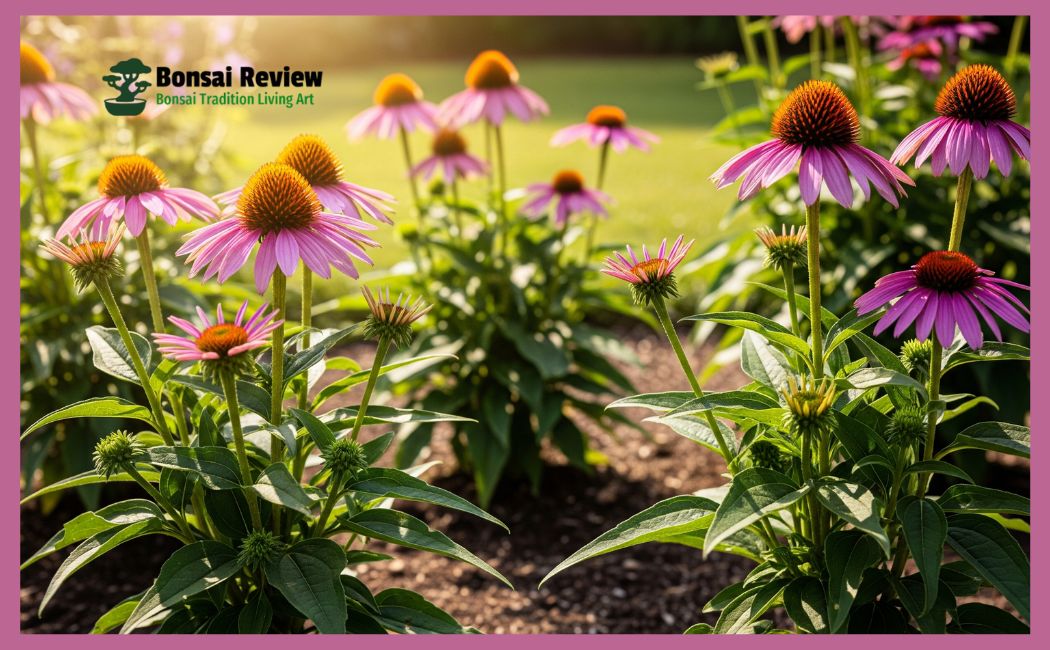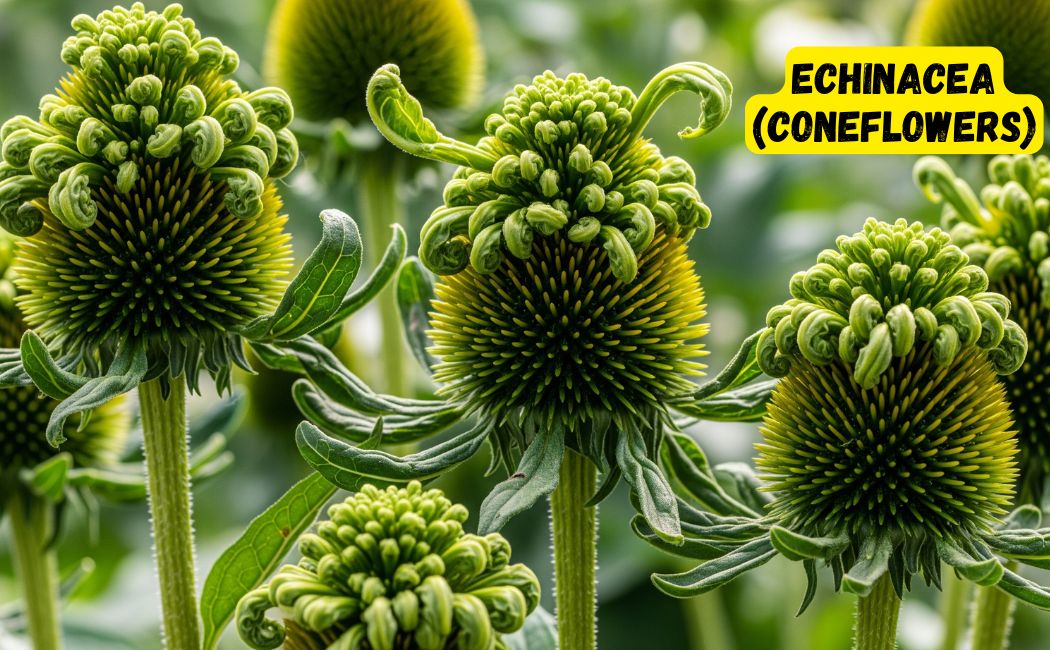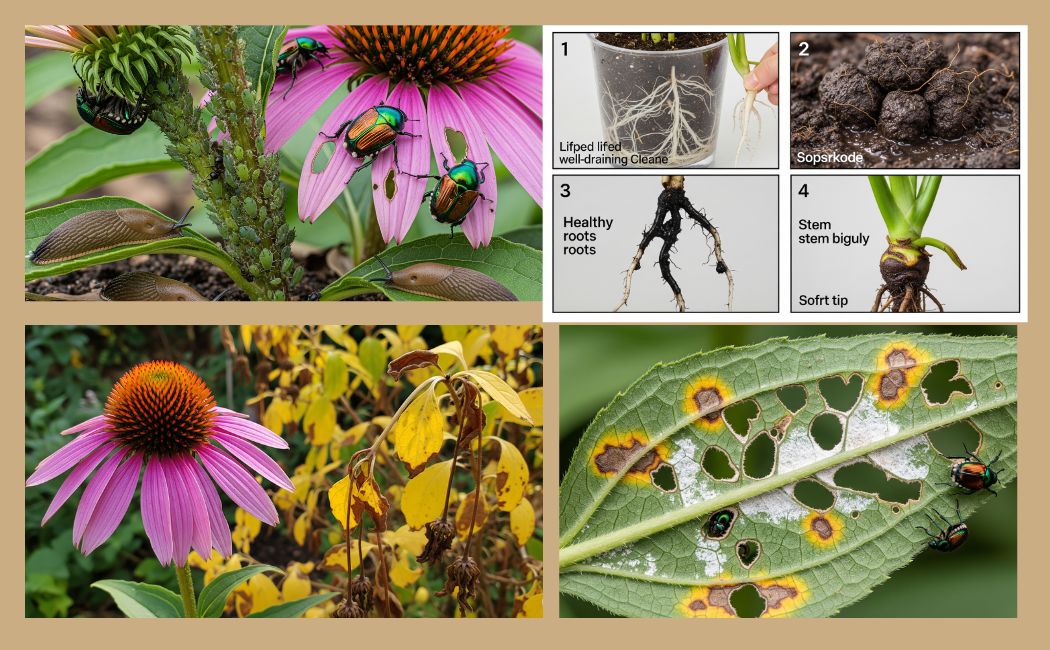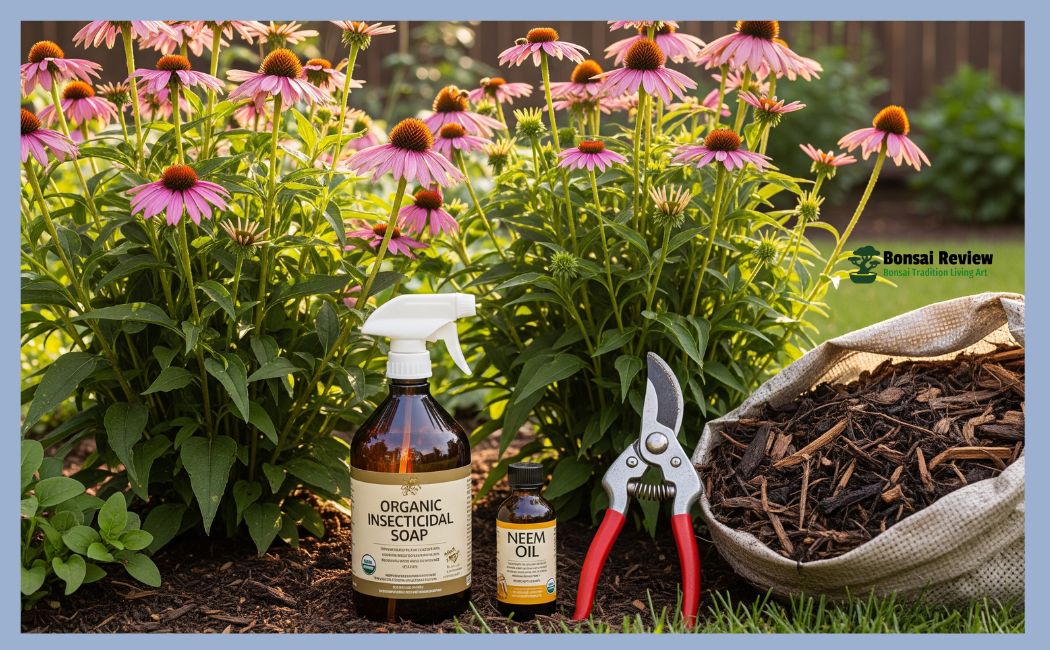Echinacea growing problems and solutions, it’s also known as coneflowers, are generally easy to grow without hassles, but can be frustrating when you’ve dwarf indoor planted these bright, hardy coneflowers expecting them to thrive.
They can encounter a few common echinacea growing problems. Overwatering can lead to root rot, while poor air circulation can encourage the growth of powdery mildew.
Most of the dwarf or bonsai plants indoor and outdoor miniature gardening. Basically, Pests such as aphids, whiteflies, and slugs can also be problematic, especially during the seedling stage. Additionally, diseases like aster yellows can affect coneflowers, causing distorted, green flowers.
If you’re caring for Echinacea purpurea (purple coneflower), Echinacea paradoxa (yellow coneflower), Echinacea angustifolia, Echinacea pallida, Echinacea tennesseensis, or Echinacea simulata.
The good news is that dwarf plant gardening most of the coneflower’s growing issues can surprise even experienced gardeners.
You might notice yellow or brown leaves, no blooms, wilting stems, holes in petals, or even green, twisted flowers. These issues often arise from overwatering, which causes root rot (Pythium, Phytophthora), poor drainage in heavy soil or pots, excessive shade, or excessive nitrogen that promotes leaf growth but inhibits flowering.
Pests such as aphids, Japanese beetles, slugs, spider mites, and leafhoppers can chew on leaves or spread diseases like aster yellows, while fungal problems like powdery mildew, leaf spot (Cercospora, Septoria), stem rot (Sclerotinia), and grey mold (Botrytis) thrive in poor airflow conditions.
With full sun, well-drained soil, proper spacing, and prompt action to remove pests or infected plants, you can revive your echinacea and keep your coneflowers blooming beautifully season after season.

Spot the Problem: How to Tell What’s Wrong with Your Echinacea
When your echinacea plants start looking unhappy, the first step is figuring out what’s wrong. Healthy coneflowers, if it’s Echinacea purpurea, Echinacea angustifolia, or Echinacea paradoxa, have strong green leaves, sturdy stems, and bright flowers.
If you see yellow or brown leaves, it could be a sign that you’re giving them too much water or that your soil drains poorly.
For example, if your garden soil feels wet days after rain, roots may be sitting in water and starting to rot.
Sometimes yellow leaves come from tiny pests like spider mites or from fungal infections such as leaf spot, which leaves dark speckles on the foliage.
If your echinacea has plenty of leaves but no blooms, it may be growing in too much shade or getting too much nitrogen from fertilizer.
Imagine a plant spending all its energy on green leaves but forgetting to make flowers, and that’s what excess nitrogen does. Wilting or drooping stems, especially at the base, can mean root rot from soggy soil or stem rot from a fungus.
You might also notice holes in petals or leaves. If the edges look ragged and uneven, it’s often Japanese beetles or caterpillars. Smooth-edged holes usually come from slugs, especially after a rainy night.
The most worrying sign is green, twisted flowers, which almost always mean that aster yellows is a disease spread by leafhoppers that cannot be cured. Another clue is a white or gray coating on the leaves.
This could be powdery mildew, which looks like someone dusted the plant with flour, or grey mold, which thrives in cool, damp conditions and makes the plant look fuzzy and sick.
Echinacea Growing Problems: Easy Ways to Keep Your Coneflowers Healthy and Blooming.
Echinacea (coneflowers) are generally easy to grow, but they can encounter a few common problems. But causes, fixes, and prevention for healthy coneflowers. Overwatering can lead to root rot, while poor air circulation can encourage the growth of powdery mildew.
Pests such as aphids, whiteflies, and slugs can also be problematic, especially during the seedling stage. Additionally, diseases like aster yellows can affect coneflowers, causing distorted, green flowers.
Here’s a more detailed look at common echinacea growing problems and solutions:
1. Overwatering and Root Rot: Echinacea prefers well-drained soil and is relatively drought-tolerant. Overwatering can lead to root rot, especially in poorly draining soil. Ensure the soil is allowed to dry out moderately between waterings.
2. Powdery Mildew: This fungal disease is more likely to occur in conditions of high humidity and poor air circulation. Provide adequate spacing between plants to improve airflow. Consider using a fungicide if the problem persists.
3. Pests Attack Issue: Aphids, whiteflies, and slugs can be common pests, particularly on seedlings. Japanese beetles can also be an occasional problem. Protect young plants with a physical barrier or use insecticidal soap or other natural sprays.
4. Aster Yellows: This disease, spread by leafhoppers, can cause deformed, green flowers. Infected plants should be removed and destroyed to prevent further spread.
5. Other Issues: Stem rot can also occur, especially with overwatering. Leaf spot fungus can be treated with fungicides or prevented by spacing plants adequately.
General Tips for Healthy Echinacea:
- Plant in well-draining soil.
- Water deeply but infrequently, especially after planting.
- Provide adequate sunlight (at least six hours per day).
- Deadhead spent flowers to encourage more blooms and prevent self-seeding if desired.
- Avoid fertilizing, as it can weaken stems.
By paying attention to these visible signs and comparing them to healthy echinacea, you can pinpoint the cause of your plant’s stress. Once you know the problem, it’s much easier to find the right fix and keep your coneflowers blooming year after year.

Causes Behind the Symptoms: Why Your Echinacea is Struggling?
Once you spot what’s wrong with your echinacea, you need to understand why it’s happening. Most problems fall into a few main categories, and each one has a fix if you act early.
1. Overwatering and Poor Drainage
Echinacea likes soil that drains well. If water pools around the roots, it can lead to root rot or stem rot. This is common when plants grow in heavy clay soil or low spots in the garden. For example, if your plant’s lower leaves are turning yellow and the stem feels mushy, the roots may be suffocating from too much moisture.
2. Too Much Shade or Excess Nitrogen
Coneflowers love sunlight. Less than 6 hours of direct light a day means fewer blooms and weaker stems. Overfertilizing, especially with high-nitrogen plant food, pushes leaf growth but delays flowering. A plant that’s all leaves and no petals is a sign you need more sun, less fertilizer.
3. Pest Damage: What’s Eating My Coneflower?
Pests such as Japanese beetles, aphids, and spider mites can weaken echinacea by feeding on leaves and flowers. Beetles chew ragged edges into petals, while spider mites leave tiny yellow spots and fine webbing. If you see insects during the day, they’re often the culprits.
4. Fungal Diseases: Common Pests and How to Get Rid of Them.
Wet, humid conditions create a home for fungi like powdery mildew, grey mold, and leaf spot. You’ll notice this if leaves have a white coating or black speckles. Crowded plants with poor air circulation are most at risk.
5. Aster Yellows: Echinacea Growing Problems or Hassles Free.
Unlike pests or fungi, the big one to watch with aster yellows comes from a microscopic parasite spread by leafhoppers. It twists flowers into green, misshapen shapes, and cannot be cured. If one plant gets it, you must remove it to protect the rest.
When you know which cause matches your plant’s symptoms, you can take targeted action. Instead of guessing, you fix the real problem, saving time, effort, and your echinacea.

Solutions That Work: Fixing Common Echinacea Growing Problems.
Echinacea growing hassles can be frustrating when you’ve planted these bright, hardy coneflowers expecting them to thrive. You might see yellow leaves, no blooms, or even twisted green flowers, and wonder what went wrong. The good news is that most of these issues. If it’s common root rot from overwatering, pests like aphids or Japanese beetles, or diseases such as powdery mildew and aster yellows, can be solved if you act quickly.
| Problem | Cause | Signs to Look For | How to Fix It |
| Yellow or brown leaves | Overwatering, poor drainage, leaf spot fungus, and spider mites | Yellowing leaves, dark spots, tiny webs | Water only when the soil dries out; improve drainage; use insecticidal soap for mites; remove infected leaves |
| No blooms or small flowers | Too much shade, excess nitrogen, and overcrowded roots | Lots of leaves, few or no flowers | Move the plant to full sun (6+ hours); reduce fertilizer use; thin crowded pots or divide plants |
| Wilting or drooping stems | Root rot, stem rot, and underwatering | Drooping stems, mushy base, dry leaves | Check soil moisture; reduce watering if soggy; improve soil drainage; remove rotten parts |
| Holes in petals or leaves | Japanese beetles, slugs, and caterpillars | Ragged or smooth-edged holes | Handpick pests; use neem oil spray; set slug traps; encourage natural predators |
| Green, twisted flowers | Aster yellows disease is spread by leafhoppers | Deformed, green flowers | Remove and destroy infected plants immediately; control leafhoppers with insect barriers |
| White or gray leaf coating | Powdery mildew, grey mold fungi | White powder or gray fuzzy patches | Improve airflow, prune crowded areas, and apply fungicide if needed |

Prevention Tips: How to Keep Your Echinacea Healthy and Blooming?
The best way to enjoy beautiful coneflowers is to stop problems before they start. Follow these easy tips to give your echinacea the right conditions:
- Plant in Full Sun: Make sure your echinacea gets at least 6 to 8 hours of direct sunlight every day. More sun means stronger stems and plenty of flowers.
- Use Well-Drained Soil: Echinacea does not like wet feet. Choose soil that drains well or plant in raised beds or pots with drainage holes. If your soil is heavy clay, mix in sand or compost to improve drainage.
- Water Wisely: Water deeply but only when the top inch of soil feels dry. Avoid overwatering, which can cause root and stem rot.
- Space Plants Properly: Leave 18 to 24 inches between each echinacea plant. Good airflow helps prevent fungal diseases like powdery mildew and leaf spot.
- Avoid Excess Fertilizer: Too much nitrogen encourages leaf growth but stops flowers. Use a balanced, slow-release fertilizer sparingly or skip fertilizing altogether.
- Remove Dead Flowers and Leaves: Deadheading spent blooms encourages new flowers and keeps plants tidy. Also, clear away fallen leaves to reduce disease risk.
- Watch for Pests Regularly: Check plants often for aphids, Japanese beetles, or leafhoppers. Early removal or treatment helps protect your plants.
- Prepare for Winter: In colder zones, add a layer of mulch around the base of your plants to protect roots during winter.
By giving your Echinacea (coneflowers) this basic care, you’ll greatly reduce growing problems and enjoy a bright, healthy garden season after season.
Special Care for Indoor Potted Echinacea (coneflowers)
Growing echinacea in pots can brighten patios, balconies, or small gardens, but container plants need extra attention to stay healthy. Here’s what you should know about echinacea care:
- Choose the Right Pot: Use a container that is at least 12 inches wide and has good drainage holes. Small pots dry out too quickly and can stress the roots.
- Use Well-Draining Soil: Fill your pot with a high-quality potting mix that drains well. Avoid garden soil, which can hold too much water and cause root rot.
- Water Carefully: Potted echinacea usually needs watering more often than garden plants, but don’t let the soil stay soggy. Check the top inch of soil and only water when it feels dry.
- Watch for Root-Bound Plants: If roots start circling the pot or coming out of drainage holes, it’s time to repot into a larger container or divide the plant. Crowded roots can stunt growth and reduce flowering.
- Place in Full Sun: Like garden echinacea, potted plants need at least 6 hours of direct sunlight to bloom well.
- Fertilize Lightly: Use a balanced, slow-release fertilizer once a season or a diluted liquid fertilizer every few weeks during the growing season. Avoid heavy feeding.
- Protect in Winter: If you live in a cold area, move your pots to a sheltered spot or indoors during winter to protect roots from freezing.
By following these simple steps, you can keep your potted echinacea thriving and blooming beautifully all season long.

When to Remove and Replant Your Echinacea
Sometimes, despite your best care, echinacea plants get sick beyond saving. Knowing when to remove and replant is key to protecting the rest of your garden.
- Aster Yellows Infection: This disease causes green, twisted flowers and stunts growth. It spreads through leafhoppers and has no cure. If you spot a plant with aster yellows, remove it immediately and destroy it to stop the disease from spreading.
- Severe Root or Stem Rot: If the base of the stem feels soft and mushy, or the roots look black and slimy, the plant likely has root or stem rot. These fungal diseases are hard to fix once advanced, so remove the plant to avoid infecting others.
- Repeated Problems in the Same Spot: If you keep losing echinacea in one area, it may be that the soil is infected or poorly draining. Remove old plants, improve the soil by adding organic matter or sand, and consider rotating with other plants before replanting echinacea.
- Pests Overrunning the Plant: When pests like Japanese beetles or aphids heavily damage a plant, and treatments don’t help, removal may be the best option to protect healthy neighbors.
When you remove a plant, clean up the area by clearing fallen leaves and debris. Wait a few weeks and prepare the soil before planting new echinacea. Healthy soil and proper care will give your new plants the best chance to thrive.
Conclusion: How to Fix Yellow Leaves and Other Echinacea Growing Issues?
Echinacea growing problems can feel frustrating, but most issues come down to simple fixes you can handle yourself. If your Echinacea (coneflowers) plants are struggling with root rot from overwatering, pests like aphids and Japanese beetles,
Diseases such as powdery mildew or aster yellows, or not getting enough sunlight, knowing the signs helps you act quickly.
By giving your echinacea plenty of sun, well-drained soil, proper spacing, and watching for pests and diseases, you create the best conditions for strong stems and beautiful blooms year after year. And if a plant gets sick beyond repair, removing it promptly protects your whole garden.
With the right care and attention, your coneflowers will reward you with vibrant flowers and healthy growth, making your bonsai or dwarf garden a cheerful, colorful space all season long. Beginner gardening lovers start and keep learning, observing, and enjoying the process, and your Echinacea (Coneflowers) will thank you with a smile when the flowers bloom!
Helpful article: How to Get Art of Bonsai Care Techniques Unique Results?
FAQs: What’s Wrong with My Coneflowers? A Beginner’s Guide to Echinacea (Coneflower) Care?
1. Why is my echinacea not blooming?
Your Echinacea (Coneflowers) might not bloom because it’s getting too much shade, too much nitrogen fertilizer, or the roots are crowded. Make sure it gets at least 6 hours of direct sunlight and avoid over-fertilizing.
2. What causes green, twisted flowers on coneflowers?
Green, twisted flowers usually mean your Echinacea (Coneflowers) plant has aster yellows, a disease spread by leafhoppers. Unfortunately, there’s no cure, so you should remove and destroy the infected plant to protect others.
3. How do I Treat Powdery Mildew on Echinacea?
Powdery mildew appears as a white powdery coating on leaves. Improve air circulation by spacing Echinacea (coneflowers) plants well, avoiding overhead watering, and consider using a fungicide if it gets severe.
4. Can I grow echinacea in indoor pots?
Yes! Use a large pot with good drainage, well-draining potting soil, and place it in full sun. Water when the top inch of soil feels dry, and repot when roots get crowded.
5. What’s eating my coneflower petals?
Common pests like Japanese beetles, slugs, caterpillars, and grasshoppers chew on petals and leaves. Handpick pests or use natural sprays like neem oil to protect your plants.
6. How do I prevent root rot in Echinacea (Coneflowers)?
Avoid overwatering and make sure your soil or pot drains well. Water only when the top inch of soil is dry, and don’t let plants sit in standing water.
7. Why is my Echinacea not growing?
Echinacea, or coneflowers, may not be growing due to a few common factors. Poor drainage leading to root rot, insufficient sunlight, or improper planting depth or spacing. Also requires well-draining soil and adequate sunlight. Early planting without enough daylight hours or starting with weak plants can hinder their growth.